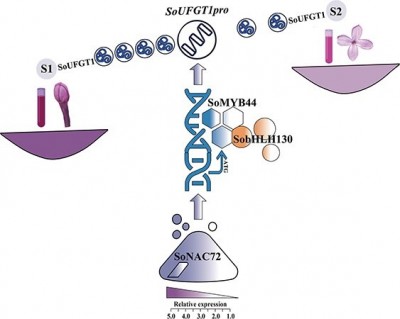Flower color not only enhances the ornamental value of plants but also plays vital ecological roles, including attracting pollinators. However, many species display color fading during blooming, a phenomenon particularly evident in lilac flowers, which transition from vibrant purple buds to lighter blossoms. Previous studies suggested that declining anthocyanin content drives this fading, yet the underlying molecular mechanism remained elusive. Anthocyanins are synthesized via complex regulatory networks involving structural genes and transcription factors. The UDP-glucose: flavonoid 3-O-glucosyltransferase (UFGT) gene family is known to stabilize anthocyanins, but its regulation in lilac was unclear. Due to these unresolved mechanisms, in-depth research on transcriptional regulation during flower color fading was urgently needed.
Researchers from the Beijing University of Agriculture reported their findings (DOI: 10.1093/hr/uhae326) in Horticulture Research on March 1, 2025, in an article titled. The study identified how three transcription factors coordinate the biosynthesis and degradation of anthocyanins in lilac petals, revealing the genetic cascade responsible for flower color fading during development.
To dissect the genetic mechanism of lilac color fading, the researchers analyzed anthocyanin levels and gene expression at two flower developmental stages. Anthocyanin content decreased by nearly 60% from the bud to full-bloom stage, correlating with the downregulation of SoUFGT1. Functional assays showed that overexpressing SoUFGT1 intensified petal pigmentation, while silencing it produced paler colors, confirming its pivotal role in anthocyanin biosynthesis.
Further analysis identified the transcription factor SoMYB44, whose expression mirrored that of SoUFGT1. Yeast one-hybrid and dual-luciferase assays confirmed that SoMYB44 directly binds to the SoUFGT1 promoter, enhancing its transcription. Meanwhile, SobHLH130 was found to interact with SoMYB44, and their co-expression amplified anthocyanin accumulation. The team also discovered SoNAC72, which activates SoMYB44 by binding its promoter region. When SoNAC72 expression decreased during flowering, downstream SoMYB44 and SoUFGT1 transcription likewise declined, leading to pigment loss. Together, these findings reveal a hierarchical regulatory pathway—SoNAC72 activates SoMYB44, which partners with SobHLH130 to drive SoUFGT1 expression, orchestrating lilac color transformation.
“Understanding how lilac petals lose their vivid purple hue bridges a key knowledge gap in plant coloration biology,” said lead author Dr. Jing Wu. “Our study not only identifies the direct transcriptional cascade controlling anthocyanin synthesis but also provides valuable genetic targets for color manipulation in ornamental plants. The SoNAC72–SoMYB44/SobHLH130 module represents a fine-tuned regulatory system that could inspire strategies for developing longer-lasting flower coloration across horticultural species.”
This study sheds light on the transcriptional control of pigment fading, revealing how coordinated gene regulation shapes flower aesthetics. The SoNAC72–SoMYB44/SobHLH130 cascade provides genetic markers for engineering flower color stability through molecular breeding and genome editing. Beyond lilac, this mechanism may serve as a model for other ornamental plants exhibiting similar color transitions. By manipulating the expression of key regulatory genes such as SoUFGT1 and SoMYB44, breeders could create cultivars with prolonged brightness and improved visual appeal, contributing to the floriculture industry and the understanding of pigment evolution in plants.
###
References
DOI
Original Source URL
https://doi.org/10.1093/hr/uhae326
Funding information
The support for this research was provided by the National Key R&D Program of China (grant numbers 2018YFD1000406) as well as the Joint Project of Beijing Municipal Education Commission and Beijing Municipal Natural Science Foundation (grant number KZ201810020028).
About Horticulture Research
Horticulture Research is an open access journal of Nanjing Agricultural University and ranked number one in the Horticulture category of the Journal Citation Reports ™ from Clarivate, 2023. The journal is committed to publishing original research articles, reviews, perspectives, comments, correspondence articles and letters to the editor related to all major horticultural plants and disciplines, including biotechnology, breeding, cellular and molecular biology, evolution, genetics, inter-species interactions, physiology, and the origination and domestication of crops.

